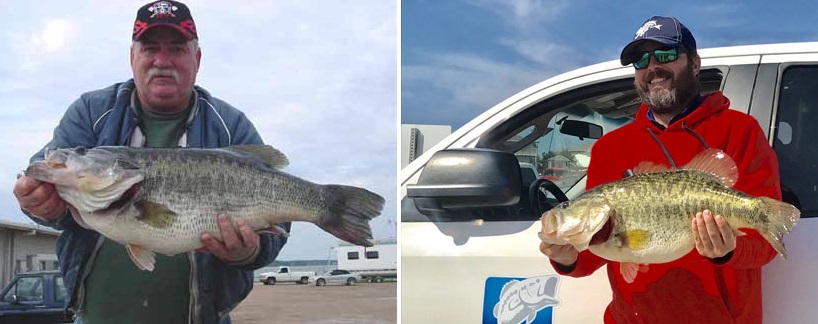ShareLunker Genetics — All in the Family
Tuesday, May 16th, 2017
[Left] Mother ShareLunker #410 | 14.48 pound| length 25.25 inches | girth 21.75 inches | Caught by Edward Reid of Crosby, TX, March 22, 2006 in Conroe [Right] Daughter ShareLunker #566 | 13.07 pounds | length 25.6 inches |girth 21.6 inches | Caught by Ryder Wicker of Fort Worth, TX, February 10, 2017 in Marine Creek in Ft. Worth | Lake record
This is Passport to Texas
Anglers dream of reeling in largemouth bass that tip the scales at 13 or more pounds. Called “ShareLunkers” Texas Parks and Wildlife encourages folks who catch these big fish to donate them to Toyota Texas Sharelunker selective breeding program.
Since the inception of the program—we just finished our 30th year—we’ve stocked over a million fingerlings of those sharelunker offspring back into the reservoirs of Texas.
Stocking lunker offspring into reservoirs increases an angler’s chance of hooking trophy bass. Kyle Brookshear coordinates the ShareLunker program for the agency, and says biologists can trace lunker lineage.
We’re able to take a small tissue sample from each sharelunker that’s caught. We can analyze that and determine who its parents are, or who its brothers and sisters are.
This year, for the first time, anglers caught “direct offspring” of previous lunkers. Although it’s taken a long time to do, it proves: from big fish, come big fish.
These ShareLunker’s are about 10 to 12 years old on average [and over 13 pounds]. It’s exciting to start to see results come in—and we should start to see more and more.
Anglers donated the “direct offspring” back to the program where they’ll become part of hatchery brood stock statewide, resulting in an increase of lunker-spawned fingerlings stocked in reservoirs.
So long term what that means is, we’ll go from stocking over a million fingerlings in the past 30 seasons of the program to stocking 6 to 8 million annually.
The Sport Fish restoration program supports our series.
For Texas Parks and Wildlife…I’m Cecilia Nasti.


 Passport to Texas is a
Passport to Texas is a  Passport to Texas is made available by:
Passport to Texas is made available by: